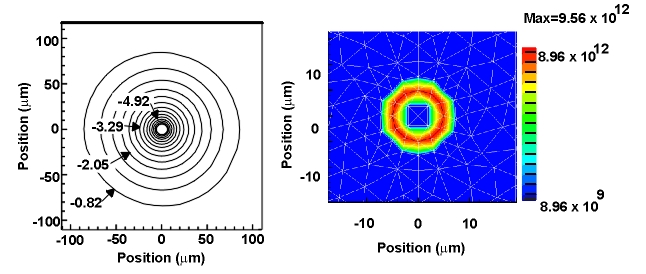

Simulation of Plasma Transport Around Complex Dust Agglomerates*
Eric R. Keiter
and Mark J. Kushner
Department of Electrical & Computer Engineering
University of Illinois at Urbana-Champaign
1406 W. Green St., Urbana, IL 61801
Dust particles generated in low temperature plasmas as used for microelectronics fabrication are often agglomerates of smaller monodisperse particles. The transport of these agglomerates, and the subsequent contamination of surfaces, depends on the details of ion-momentum transfer (ion-drag) to, and electrostatic forces on, the agglomerate. Given that the surface charge distribution and local electric fields in the vicinity of the agglomerate depends on its shape, the subsequent forces on the agglomerate will also be a function of shape. We have developed a numerical plasma simulation with which we can obtain the surface charge of a complex agglomerate and the resultant electrostatic fields. We find that the charge distribution on the agglomerates is generally non-uniform, a consequence of both shadowing and charge depletion. The ion-momentum transfer cross section, calculated using a Monte Carlo simulation, also depends on the shape of the agglomerate.
2. Computational Model
The plasma simulation we developed for this study is an implicit drift-diffusion model for a single positive ion, electrons and the electric potential. An implicit scheme was required due to the small spatial scale of the numerical mesh (< 1 m m). Since the model is 2-dimensional, the agglomerates can only be resolved as collections of rods, however we believe the conclusions can be generalized to 3-dimensional structures. The plasma transport is being represented by a drift-diffusion formalism. Therefore, the orbital motion of ions which results in the plasma shielding distance around the particle being given by the linearized Debye length cannot be resolved. As a consequence, the shielding distances produced by the model are best characterized by the electron Debye length. Since it is the ratio of the agglomerate size to the Debye shielding length which is the important parameter, we have chosen appropriately sized particles so that this ratio is of the desired magnitude. The calculation of the ion drag cross section, which is performed using a Monte Carlo simulation, does resolve the proper orbital motion and so the resulting cross sections should be accurate.

Fig. 1: Example mesh for fluid simulation. Sixteen-sphere agglomerate.
3. Results
Results for a single-sphere agglomerate and a sixteen-sphere agglomerate are shown in Figs. 2-3.

Fig. 2: Potential, surface charge density for a single-sphere agglomerate

Fig. 3: Potential, surface charge density for a sixteen-sphere agglomerate
*
This work is supported by the Semiconductor Research Corporation, the National Science Foundation, Advanced Research Projects Administration and the University of Wisconsin ERC for Plasma Aided Manufacturing.Last updated: January 27, 1998.